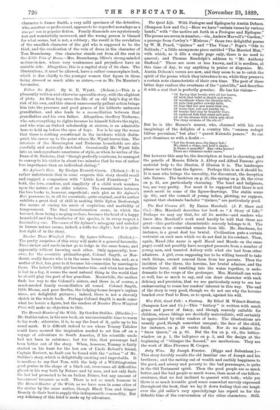The Quiet Life. With Prologue and Epilogue by Austin Dobson.
(Sampson Low and Co.)—Here we have "certain verses by various hands," with " the motive set forth in a Prologue and Epilogue." The poems are seven in number,—viz., Andrew Marvell's " Garden ;" a passage from Cowley's " Mistress ;" those two delightful poems by W. M. Praed, " Quince " and " The Vicar ;" Pope's " Ode to Solitude ;" a little anonymous piece entitled "The Married Man," with which, as it fills a single page only, there is no need to quarrel ; and Thomas Randolph's address to " Mr. Anthony Stafford." These are more or less known, and it is needless, at this time of day, to say anything in praise or dispraise. Mr. Austin Dobson's verses are new, and they seem to us to catch the spirit of the poems which they introduce to us, while they preserve a certain note characteristic of their own time. The poet of these latter days realises the sweetness of the "quiet life," and describes it with a zest that is perfectly genuine. He has his visions- " Of Spring that breaks with all her leaves, Of birds that build in thatch and eaves, Of woodlands where the throstle calls, Of girls that gather cowslip balls, Of kine that low and lambs that cry, Of wains that jolt and rumble by, Of brooks that sing by brambly ways, Of sunburnt folk that stand and gaze, Of all the dreams with which men cheat The stony sermons of the street."
But he is like Horace's usurer, who, charmed with his own imaginings of the delights of a country life, " omnem redegit Idibus pecuniam," but alas ! " quserit Kalendis ponere." So our poet dismisses us with a doubt :—
" Let the dream pass, the fancy fade! We clutch a shape, and hold a shade. Is Peace so peaceful? Nay—who knows? There are volcanoes under snows."
But however this maybe, the description at least is charming, and the pencils of Messrs. Edwin A. Abbey and Alfred Parsons give material help to the illusion, if illusion it is. The landscapes please us better than the figures. Perhaps this is as it should be. It is man who brings the unreality, the discontent, the deception into Nature. The beehives on p. 25, the spring on p. 29, the river on p. 31, are particularly charming. The head and tailpieces, too, are very pretty. Nor must it be supposed that there is not much merit in some of the figure-drawings. The stable scene (p. 43), and the council of young ladies, plotting, we suppose, against that obstinate bachelor "Quince," are particularly good.






































 Previous page
Previous page